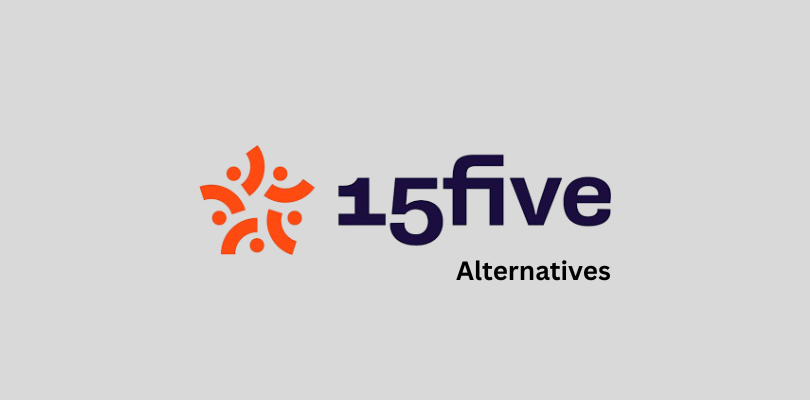Did you know your pizza parties, Monday motivation emails, or Friday fun sessions cannot stop those RESIGNATION LETTERS? Yeah, employee engagement takes more than gimmicks, and let me tell you the differences.
Over the last 12 years, I’ve partnered with 200+ companies and analyzed thousands of engagement programs, learning what truly sparks loyalty and performance. One clear lesson that stands out is that engagement is less about flashy initiatives and more about consistent behaviors that earn respect.
So, in this blog, I will use my experience to help you explore:
- What employee engagement is and why it matters.
- The challenges, benefits, and strategies behind it.
- Tools, examples, and trends shaping the future.
Follow these insights and build a stronger workplace culture, higher retention, and lasting employee loyalty.
Sounds good? Let’s start with an important question:
What Is Employee Engagement?
Employee engagement is the emotional connection employees build with their work, their team, and their organization. It is different from job satisfaction, which only shows whether someone is content with their role. Engagement means enthusiasm, initiative, and a willingness to go the extra mile because the work feels meaningful.
For example, when I managed a small project team, one colleague wasn’t just satisfied with completing assigned tasks. She regularly suggested new ways to streamline our process, volunteered to mentor new hires, and celebrated team wins. That active involvement showed true engagement and lifted the whole team’s performance.
Now that we understand what employee engagement really means, I want to step back and look at where things stand today. The numbers tell a story that is too important to ignore.
The Current State of Employee Engagement
“When people are financially invested, they want a return. When people are emotionally invested, they want to contribute.”
— Simon Sinek
American author & inspirational speaker
In my years of working with organizations, I’ve seen how quickly engagement levels can shift. The 2026 data shows us some striking trends:
Declining U.S. Engagement Rates
Only about 31% of U.S. employees are engaged, the lowest figure in ten years.
If I were showing this to a client, I’d use a line graph from 2015 to 2025 to highlight how steadily the decline has unfolded.

Global Engagement Lag
Globally, engagement is even lower, hovering around 21%.
A simple bar chart comparing the U.S. to the world average makes the contrast immediately clear.

Rise of Active Disengagement
About 17% of employees are “actively disengaged,” meaning they are not just unhappy but also spreading negativity.
I often represent this with a pie chart showing three slices: engaged, not engaged, and actively disengaged.

Generational Differences
Younger employees, especially those between 18 and 24, report higher engagement, nearly 77% in some surveys, compared to older age groups.
A bar chart by age group can easily show how Gen Z differs from Millennials or Gen X.

Burnout and Well-Being Concerns
More than 75% of employees, and even 63% of managers, report burnout or detachment. I like to visualize this with a side-by-side infographic comparing employees and managers.

Retention and Turnover Impact
Disengagement is directly tied to rising turnover, with companies losing billions in replacement costs and lost productivity.
A trend line showing how engagement levels dip while turnover rises paints this picture vividly.

These trends tell me one thing: employee engagement is not just a human resources concern; it’s a business survival issue. Why is employee engagement important? Because it directly impacts retention, productivity, and workplace culture in ways no perk ever could.
Cool?
Now that we’ve explored the overall state of engagement, I want to clarify something I often see leaders get wrong.
In my years of working with organizations, I’ve noticed that many people use job satisfaction and employee engagement interchangeably. They sound similar, but they drive very different results.
Employee Engagement vs Job Satisfaction
When I assess a workplace, I always separate the two.
Job satisfaction tells me whether people feel content with their pay, role, or environment. Employee engagement, on the other hand, tells me whether they are emotionally connected to the mission and willing to give discretionary effort.
Both are valuable, but only engagement builds lasting loyalty and a stronger workplace culture. Here’s how the two compare in practice:
| Aspect | Employee Engagement | Job Satisfaction |
|---|---|---|
| Definition | The emotional commitment an employee feels toward their work and the organization. | The level of contentment an employee feels with their role, pay, or workplace. |
| Focus | Involvement, enthusiasm, and willingness to go beyond basic responsibilities. | Comfort, stability, and meeting personal expectations. |
| Measurement | Assessed through surveys on motivation, purpose, and connection to company goals. | Measured by surveys on pay, benefits, and working conditions. |
| Impact on Performance | Directly linked to productivity, innovation, and discretionary effort. | Ensures employees remain present and less likely to complain, but doesn’t guarantee high output. |
| Long-Term Effect | Builds employee loyalty, retention, and a stronger organizational culture. | Reduces turnover risk temporarily but may not inspire growth or innovation. |
| Example | I once worked with a sales team where an engaged employee not only exceeded targets but also introduced new tactics that lifted the entire team’s results. | A satisfied employee in the same team felt secure with good pay and benefits, but rarely contributed ideas beyond their core tasks. |
Lesson Learned:
If you stop at satisfaction, you may keep employees comfortable, but if you build engagement, you unlock employee performance, innovation, and long-term commitment.
Now that we’ve seen how engagement and satisfaction differ, it’s time to talk about the real-world obstacles. Over the years, I’ve sat with executives, frontline workers, and HR leaders, and the same pain points around engagement come up again and again.
Employee Engagement Challenges & Pain Points
I have seen companies lose their best people, stall innovation, and weaken their culture simply because they did not address these issues early enough. From my work with different teams, these are the pain points that stand out most clearly.
1. When Recognition Is Missing, Motivation and Morale Begin to Collapse
I remember sitting with a group of engineers who told me, “We only hear from leadership when something breaks.”
That sentence summed up their frustration.
They were doing valuable work, but no one acknowledged it. When employee recognition is absent, people lose their drive.
Recognition does not always have to be formal or expensive. The most effective recognition I have seen is personal and immediate, like a manager saying thank you at the end of a long week.
2. Lack of Career Growth Creates Silent Disengagement Over Time
In a professional services firm I advised, mid-level managers openly said they felt “stuck in neutral.”

Their pay was fair, but their motivation was fading because they could not see a clear path forward. They had job satisfaction, but they lacked engagement.
Engagement grows when employees see learning opportunities, mentoring, or a chance to move into new roles. When growth is absent, even top performers begin to quietly pull back, waiting for the day when another company offers them what their current employer does not.
3. Poor Communication and Trust Gaps Break the Relationship Between Leaders and Teams
I have been in executive meetings where leaders proudly stated, “Everyone knows our vision.”
Later that same day, I heard frontline employees say, “We do not know where the company is heading.” That kind of disconnect is dangerous because it erodes trust.
Employees want open communication and honesty from leadership. When the messages are unclear or one-sided, people feel excluded. The most engaged companies I have seen make communication two-way, using forums, survey templates, and direct updates to build trust with their people.
4. Remote Work and Hybrid Models Often Lead to Isolation and Disconnection
During a focus group I led at the height of remote work, one employee admitted, “Some days I feel invisible. I just log in, finish my tasks, and log out.”

That comment captured the loneliness that many employees experience when working from home.
The absence of small daily interactions like coffee breaks or hallway conversations removes a layer of human connection. Organizations that succeed with remote engagement create intentional rituals: virtual recognition ceremonies, weekly check-ins, or casual online gatherings that make people feel part of something bigger.
5. Inefficient Tools and Processes Frustrate Employees Instead of Supporting Them
At one company I consulted for, managers dreaded using their performance management platform.
One even joked, “It takes longer to log in than to finish the review.” When tools are this clunky, employees stop using them altogether, which makes engagement efforts meaningless.
Technology should remove friction, not add to it. Employees want systems that make feedback, performance reviews, and communication simple. When tools get in the way, people feel unsupported, and engagement naturally drops.
6. A Toxic or Misaligned Culture Can Undo Every Engagement Initiative
Culture is the hidden force behind engagement.
At one organization, employees told me, “No matter how hard we work, promotions go to favorites.” The result was a sharp drop in morale.

Even the company’s recognition programs failed, because employees no longer trusted the fairness of leadership decisions.
A toxic culture cannot be masked with perks or surveys. It requires a serious commitment from leaders to rebuild trust, align values with actions, and hold managers accountable for how they treat people.
Now that the challenges are clear, it is equally important to see the rewards that come when engagement is strong.
I have seen organizations transform simply by investing in the right practices. The benefits are not limited to happier employees; they extend to stronger business performance and healthier cultures.
Benefits of Employee Engagement
Employee engagement benefits go beyond survey scores; they show up in daily work, customer interactions, and team growth.
From productivity to retention, the advantages of engagement ripple through every corner of an organization.
These are the benefits I have seen most often in my years of practice.
1. Higher Productivity Comes Naturally When Employees Feel Connected
When employees care about their work, they give more than the minimum effort.
In one financial firm I worked with, engaged employees consistently suggested improvements to save clients time.
Their output was not only higher, it was also smarter. Productivity is not the result of pressure; it flows naturally from engagement.
2. Retention Improves and Turnover Costs Drop Significantly
I have compared branches of the same company where one team had high engagement and another did not.
The engaged team had far lower turnover, and employees openly said, “I see a future here.” That loyalty reduced hiring costs and kept expertise within the business. Retention is one of the clearest signs of engagement in action.

3. Engaged Teams Deliver Better Customer Experiences and Build Loyalty
Customers can instantly sense the difference between an engaged employee and a disengaged one. In a client’s retail chain, the most engaged teams consistently received the best customer satisfaction scores.
Employees who are connected to their roles take time to listen, solve problems, and treat customers with genuine care. This builds long-term loyalty that no marketing campaign can buy.
4. Innovation and Creativity Flourish in an Engaged Workplace
Engaged employees do not stop at doing what is required. They look for ways to improve, experiment, and innovate.
At a technology startup I advised, one employee’s suggestion for a new product line turned into a revenue-generating success. That kind of creativity only surfaces when people feel invested in the company’s success.
5. A Positive Work Culture Spreads Across Teams and Strengthens Morale
Engagement is contagious.
I have seen one highly engaged department set an example for others, creating rituals of recognition and collaboration that gradually spread company-wide. A positive culture rooted in engagement becomes self-reinforcing, lifting morale across the entire organization.
Now that we know the benefits of engagement, the next step is to measure it in a way that gives you honest, actionable insights.
From my experience, organizations that keep their surveys simple and regular see the best results.
How to Measure Employee Engagement
Employee engagement surveys are the most effective tool to capture how employees feel about their work, culture, and leadership.
Tools like PeopleGoal provide pre-built templates in the App Store that make the process faster while still allowing you to tailor questions to your needs.
1. Choose a Survey Template from the Engagement Category
Start with a ready-to-use survey designed for engagement. Templates include proven questions that cover satisfaction, motivation, and workplace culture.
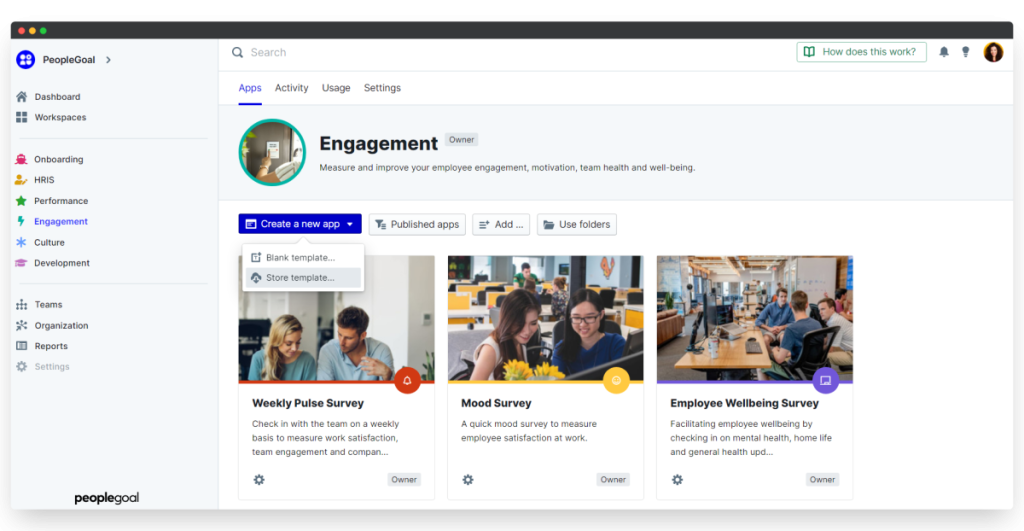
2. Customize the Questions to Fit Your Organization
Adjust the survey to reflect your culture and goals. Add pulse survey items, eNPS scores, or custom fields to make feedback more relevant.
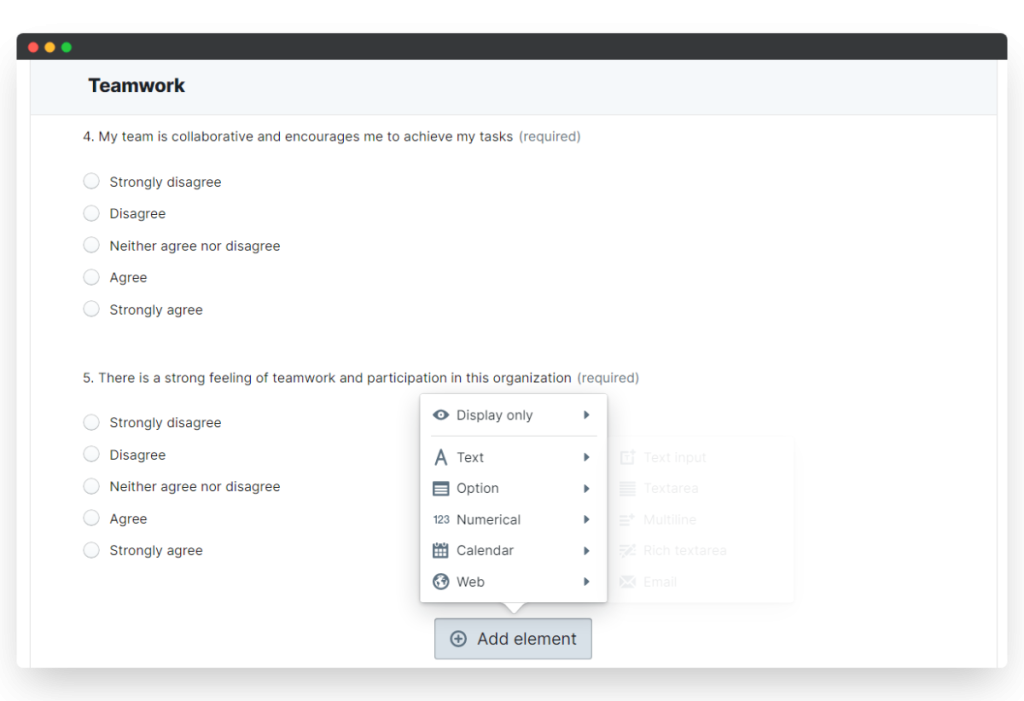
3. Enable Anonymous Responses for Honest Feedback
Set your survey to anonymous so employees feel safe to share their opinions. Anonymity leads to more candid and valuable responses.
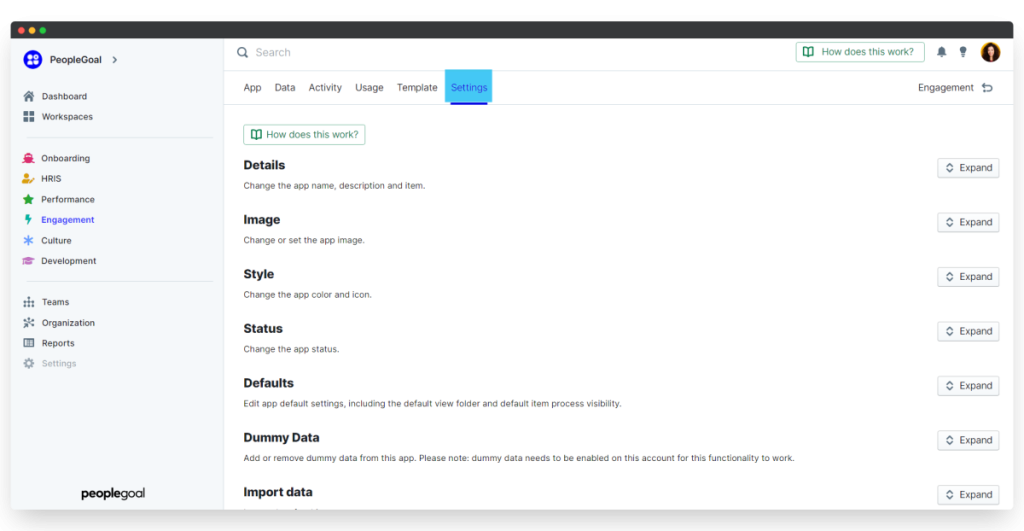
4. Assign Permissions and Share with the Right Groups
Define who will take the survey and who can see the results. Clear permissions protect privacy and give leaders the right level of visibility.
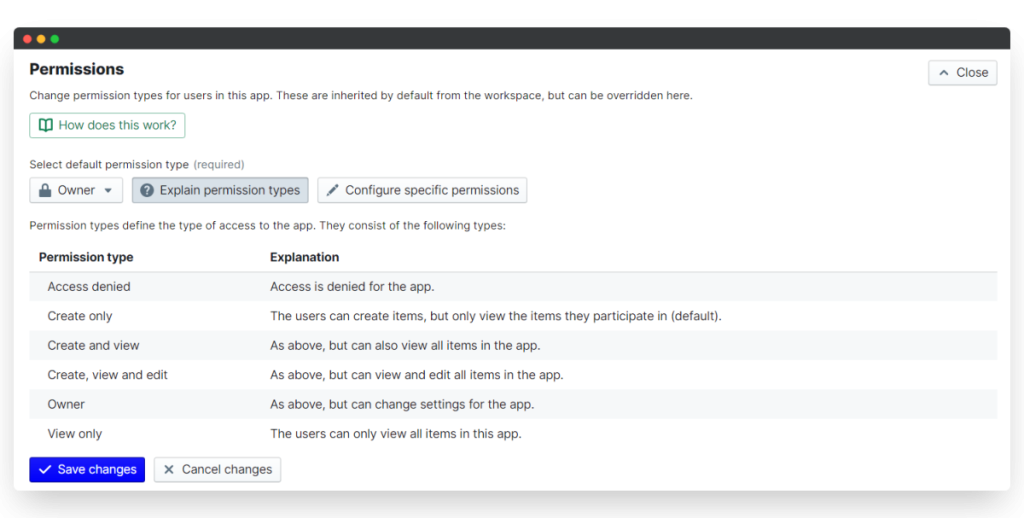
5. Launch the Survey, Schedule Recurring Cycles, and Track Trends
Distribute the survey immediately or schedule it at regular intervals, such as quarterly. Compare results over time to spot patterns and take action quickly.
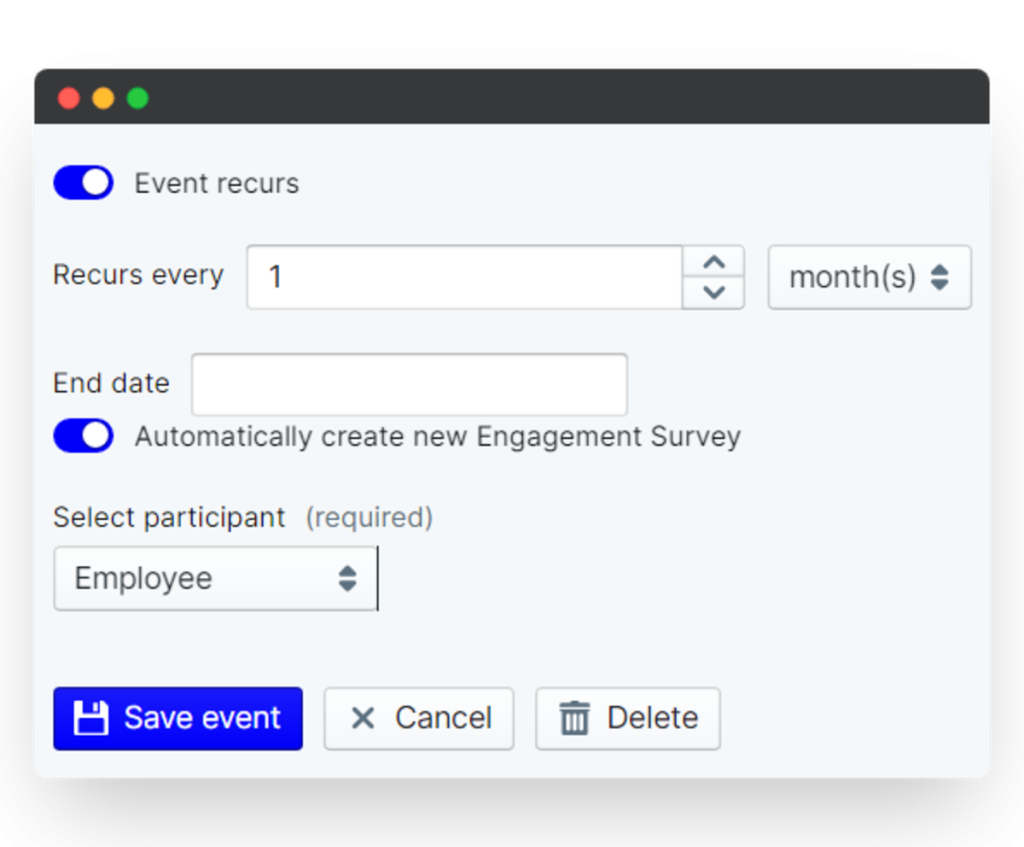
That’s it!
That’s all you need to know to create and measure an employee engagement survey to get real outcomes that drive results.
For a better view, watch:
Sounds good?
Okay, so you have seen how to measure engagement, but measurement without action is like a compass without a map. To truly transform your workplace, you need practical, tested approaches that employees actually respond to.
Employee Engagement Strategies That Inspire Real Results

“To build a culture of engagement, it is important to incorporate training on intrinsic motivation and employee engagement into management development programs.”
— Kenneth Thomas
American Organizational Behavior Expert
Employee engagement strategies work best when they combine structure with creativity.
Over the years, I’ve seen that organizations that invest in recognition, growth, communication, balance, and culture consistently achieve higher performance and stronger loyalty.
Below are the strategies I recommend, with examples and activities you can bring to life right away.
1. Open Communication Builds a Foundation of Trust
Employees want to be heard, not just managed. Strong communication fosters clarity, trust, and connection across all levels of the workplace culture.
Open channels are one of the most effective examples of employee engagement strategies because they reduce silos and strengthen team morale.
Town Halls and Ask-Me-Anything Sessions
Hold monthly or quarterly open forums where leadership answers employee questions directly. Encourage anonymous submissions to ensure honesty. These sessions improve employee engagement by showing that leadership values employee perspectives.

Digital Feedback Channels
Use tools like Slack, MS Teams, or survey apps to build continuous feedback loops. Employees can share concerns, ideas, or pulse feedback without waiting for annual reviews.
Storytelling by Leaders
Encourage leaders to share personal stories of challenges, successes, or lessons. Storytelling makes leadership more human and creates stronger employee connections.
2. Recognition Turns Everyday Effort Into Lasting Motivation
Recognition is one of the most cost-effective employee engagement strategies. A workplace culture that celebrates effort ensures employees feel valued and motivated, which in turn drives employee loyalty and team morale.
Peer-to-Peer Recognition
Set up recognition programs where employees can thank or highlight each other’s contributions. Digital badges, points systems, or “kudos” boards encourage positivity across teams.

Manager Acknowledgment in Real Time
Train managers to recognize good work on the spot — during meetings or project updates. Recognition in the moment boosts employee morale instantly.
Fun Recognition Activities
Host themed appreciation days, like “Shoutout Fridays” or “High-Five Mondays,” to make recognition part of the routine. These creative employee engagement ideas build loyalty through everyday celebration.
3. Career Development Keeps Talent Energized
Employees disengage when they feel stuck. Clear career development opportunities show the company’s commitment to long-term employee retention and growth.
Learning and Development Programs
Offer structured programs with online courses, mentorship, and certifications. Career development tied to role progression keeps employees engaged and loyal.

Career Roadmapping
Help employees design personalized career roadmaps in one-on-one sessions. Define milestones, required skills, and opportunities for advancement to give employees a clear sense of direction.
Shadowing and Rotations
Introduce job shadowing or rotational programs to expose employees to different roles. This builds cross-functional skills and ensures talent remains motivated instead of stagnating.
4. Work-Life Balance Keeps Energy Levels High
Engagement collapses when employees are overworked. Supporting balance shows care for employees’ well-being, strengthens team morale, and improves retention.
Flexible Work Schedules
Allow hybrid or flexible schedules so employees can manage personal responsibilities. This builds accountability and satisfaction while supporting employee loyalty.
Wellness Initiatives
Introduce wellness challenges like step competitions, yoga sessions, or mindfulness workshops. These activities improve employee engagement by promoting both health and fun.

Breakout Activities and Games
Encourage energizing breaks during long days. Online trivia, 15-minute stretch sessions, or brainstorming games lift morale and refresh focus.
5. Purpose Gives Work Meaning Beyond the Paycheck
Employees want to know their work matters. Connecting their daily tasks to the bigger mission builds pride, motivation, and loyalty. Purpose-driven initiatives are among the best employee engagement strategies for companies.
Mission Alignment Workshops
Run quarterly sessions where leaders explain how individual projects tie to company goals. This improves employee engagement by linking tasks to mission impact.
Impact Stories
Share customer testimonials or case studies that highlight how employees made a difference. These stories foster pride and employee loyalty.
Volunteering Opportunities
Organize CSR initiatives or volunteering days. Shared purpose builds bonds across teams and strengthens workplace culture.
6. Culture and Inclusion Create Belonging
Workplace culture and inclusion are at the heart of long-term retention. Employees feel engaged when they feel safe, valued, and included. Inclusive practices are essential leadership strategies for employee engagement.
Diversity Celebrations
Celebrate cultural events, awareness days, and heritage months with activities and learning sessions. This fosters respect and strengthens workplace culture.

Employee Resource Groups (ERGs)
Support ERGs for shared identities or interests — such as women in leadership, LGBTQ+, or new parents. These networks improve employee loyalty and retention.
Inclusive Games and Activities
Organize team-building challenges like cross-department hackathons or innovation contests that bring diverse groups together.
7. Activities and Rituals Add Fun to Daily Work
Engagement thrives when work is enjoyable as well as meaningful. Fun rituals and games are examples of employee engagement strategies that sustain energy and motivation.
Team-Building Games
Run scavenger hunts, trivia nights, or virtual escape rooms to build collaboration. Remote-friendly tools like ProProfs Quiz Maker or QuizBreaker make this easy.

Weekly Rituals
Start traditions such as “Friday Wins” meetings, where teams share achievements, or “Coffee Roulette,” where employees are paired for informal chats. These rituals improve team morale.
Creative Breaks
Encourage informal clubs or challenges — like book clubs, art competitions, or cooking contests. These creative employee engagement ideas keep employees connected and loyal.
Interesting, right? Here’s something more interesting for you:
Now that you have a working measurement rhythm, the real test is distance. Remote or hybrid should not dilute culture or performance.
Let me show you how I keep engagement strong when the team is split across time zones.
Employee Engagement for Remote & Hybrid Teams
Remote and hybrid work changes how people communicate, get recognized, and feel included. I learned early that remote employee engagement is built on cadence, clarity, and visible care.
When internal communications are consistent and participation feels fair, engaging remote employees becomes a daily habit rather than a quarterly project.
Where Remote and Hybrid Help (and Where They Do Not)
Remote helps with focus, wider hiring, and inclusive asynchronous work that suits different thinking styles.
It also opens doors for caregivers and those outside major hubs.
Remote work hurts when loneliness creeps in, calendars fill with meetings, or proximity bias favors office faces. If decisions live in hallways, the employee experience fragments and morale drops.

What Effective Remote Engagement Looks Like in Practice
- I run 30-minute one-to-ones weekly or every other week. We cover wins, blockers, and one improvement target.
- We publish a clear meeting cadence: short stand-ups, a weekly team review, and a monthly retrospective that ends with one change, one owner, one date.
- Updates are asynchronous first. Chat for quick notes, documents for decisions, video for debate. Everyone knows where truth lives.
- Recognition is public and frequent. We keep a shoutout channel, open meetings with wins, and send small thank-you notes for milestones.
- Meetings follow equity rules. One person per screen, cameras optional, round-robin input, actions captured in a shared document.
- Once a month we run a five-question pulse survey. Results are shared, and we commit to one action before the next pulse. That is how to improve employee engagement in a remote workplace without adding noise.
- Quarterly, if budgets allow, we add an in-person anchor day for planning and relationship building. If travel is not possible, we run a virtual offsite with shorter blocks and clear breaks. These are practical virtual employee engagement strategies that stick.
A Quick Comparison From My Teams
A new hire in a different time zone felt invisible within two weeks. We added a buddy, a weekly Coffee Roulette, and a written week-in-review ritual. Participation jumped, and their questions surfaced earlier.
A hybrid squad kept missing decisions because managers resolved issues in hallway chats. We moved choices into a shared decision log and adopted the one-screen meeting rule. Rework fell, and the team’s confidence rose.
A senior contributor was burning out. We set quiet hours, trimmed recurring meetings, and tracked workload in the stand-up. Energy returned within a month, and quality stabilized.
How to Combine Office and Home (My Playbook)
- Keep a predictable weekly cadence that everyone can name without checking a calendar.
- Give each tool a job: chat for quick updates, video for decisions, documents for records, and a project board for status.
- Make recognition lightweight and visible. Five minutes for wins in every team meeting is enough to lift motivation.
- Bake inclusion into the mechanics. Rotate facilitation, use structured rounds, and post decisions where all can see them.
- Measure little and often. Short pulse surveys, eNPS, and a simple heat map by theme guide on where to act next.
- Onboarding sets the tone. Ship a clear schedule, assign a buddy, set three week-one goals, and send a welcome note that feels human.
If you adopt one change from this section, make it this: set a weekly communication cadence and one monthly pulse, then act on a single improvement every cycle.
We’ve covered how remote and hybrid teams can stay engaged, but none of it works without strong leadership. Engagement is shaped most directly by managers and leaders, their choices set the tone for the entire workplace.
The Role of Leadership & Managers in Employee Engagement
The role of managers in employee engagement is one of the most decisive factors in any organization. Leaders shape workplace culture daily, not through slogans but through their actions.
Employees often decide whether to stay, give their best, or disengage based on how they are led. Leadership in employee engagement is not optional — it is the foundation for building employee loyalty, team morale, and long-term retention.
Here’s what makes the difference.
1. Setting the Tone With Transparent Communication
When leaders share openly, employees follow.

I worked with one CEO who started every monthly meeting with a five-minute update on company challenges. His honesty built trust, even during tough quarters. By contrast, in another firm where leadership kept quiet, rumors filled the gap and engagement sank.
Here’s what you can do:
- Host regular all-hands meetings where leaders take questions directly from employees. These forums reduce speculation and show that leadership values transparency, which strengthens workplace culture.
- Share progress notes after board or leadership meetings so employees hear updates firsthand instead of through secondhand channels. This is one of the simplest leadership strategies for employee engagement.
- Model candor in smaller team discussions by openly admitting challenges or mistakes. This makes it safer for managers at every level to do the same and shows how managers improve employee engagement through trust.
2. Recognizing Effort as a Leadership Habit
Employees do not forget recognition from their managers. I still remember one engineer telling me, “That one thank-you from my manager meant more than the bonus.”
Leaders who give regular acknowledgment make employees feel valued. Recognition is not about speeches but daily habits that drive retention and team morale.
Try this:
- Build a two-minute recognition round into weekly team meetings, where recent contributions are acknowledged in front of peers. This builds employee loyalty by showing that effort is noticed.
- Call out employee achievements in company-wide newsletters to highlight their work to the entire organization and reinforce a culture of recognition.
- Write short but personal notes after major milestones, tying the recognition back to company values and goals. This leadership strategy for employee engagement connects recognition to meaning.
3. Coaching and Career Growth Conversations
Managers who coach rather than just assign tasks unlock loyalty. I coached a department head who shifted one-on-ones from status updates to growth discussions. Within six months, employee retention in her team jumped.
Growth remains one of the most reliable ways to strengthen engagement.

One way to apply this:
- Use one-on-ones as dedicated employee development sessions where you discuss skills, aspirations, and challenges instead of just task updates. This approach shows the role of leadership in employee engagement clearly.
- Map out potential career paths and share them openly so employees know what steps lead to progression within the company. This improves both employee loyalty and retention.
- Connect employees with mentors or peer coaches who can provide perspective and support beyond their direct manager. Coaching is one of the strongest leadership strategies for employee engagement.
4. Holding Engagement as a Leadership KPI
In companies where engagement is a leadership metric, it thrives. I worked with a client who tied part of the manager bonuses to engagement survey results. It was not about gaming the system; it drove managers to act on survey feedback and close the loop with their teams.
Here’s how to make this real:
- Set clear manager KPIs around engagement, retention, and team morale, and review them as part of leadership evaluations. This shows exactly how managers improve employee engagement.
- Train leaders on how to interpret survey data and turn insights into practical action plans. Leadership in employee engagement becomes measurable only when linked to follow-through.
- Share engagement dashboards with managers so they can track progress in real time and adjust their approach quickly. This integrates leadership strategies for employee engagement into daily practice.
5. Leading by Example in Work-Life Balance
Employees mirror leaders. If managers send emails at midnight, staff will feel pressure to do the same.

In one hybrid company, the leadership team made a rule: no messages after 7 p.m. Engagement scores for work-life balance shot up in the next survey.
Here’s how to apply it:
- Respect no-meeting hours and avoid sending late-night emails, showing employees that boundaries are respected. This strengthens workplace culture.
- Encourage breaks by taking them yourself, whether that’s stepping away for lunch or blocking focus time on your calendar. This visible behavior is a leadership strategy for employee engagement that normalizes balance.
- Publicly praise managers or employees who set healthy boundaries, reinforcing the value of balance across the organization. This builds employee loyalty and improves retention by reducing burnout.
Now that we’ve looked at the role of leadership, the next step is scaling those efforts with the right systems.
Tools and Technology for Employee Engagement
The right tools and technology for employee engagement help companies move beyond guesswork.
In my experience, organizations that adopt employee engagement software, survey platforms, and recognition tools see measurable improvements in employee loyalty, retention, workplace culture, and team morale.
Here are the best employee engagement tools and how to use them effectively.
1. Employee Engagement Software Simplifies Measurement
Employee engagement surveys are the backbone of any strategy. Software platforms make it easy to collect data, track trends, and identify where managers need to focus. This is how managers improve employee engagement with clarity rather than assumptions.
Here’s what you can do:
- Use employee engagement survey software to run pulse surveys, annual reviews, and eNPS questions. These surveys are one of the best employee engagement strategies for companies because they reveal what truly drives loyalty and retention.
- Automate survey reminders and analysis so managers can act quickly. Faster cycles build team morale and prove leadership in employee engagement is serious about change.
- Share results transparently with dashboards. When employees see data acted upon, workplace culture strengthens, and employee loyalty grows.
2. Recognition Platforms Build Daily Motivation
Recognition platforms are employee engagement tools that make appreciation visible. They support employee retention by ensuring recognition happens consistently rather than sporadically.
Try this:
- Set up digital recognition boards or points systems where peers highlight each other’s contributions. Peer recognition fuels workplace culture and strengthens team morale.
- Encourage managers to give real-time recognition through the platform. These leadership strategies for employee engagement make recognition a daily habit.
- Link recognition to company values. When appreciation reflects the bigger mission, employee loyalty deepens and retention improves.
3. Performance Management Systems Align Growth With Engagement
Performance management systems tie career development directly to employee engagement. They provide managers with structured ways to coach, support career paths, and measure outcomes.
One approach is:
- Use goal-setting frameworks like Objectives & Key Results or SMART goals within performance software. Clear expectations improve employee engagement and workplace culture.
- Integrate feedback tools so managers can deliver continuous coaching. This shows the role of managers in employee engagement and strengthens employee loyalty.
- Track retention and promotion data inside the system. Transparent growth opportunities reduce turnover and boost team morale.
4. Learning and Development Platforms Energize Employees
Career development is one of the strongest leadership strategies for employee engagement. Learning and development platforms provide easy access to training that keeps employees growing and motivated.
Here’s how to apply it:
- Offer employees on-demand courses and certifications that align with their career roadmaps. This builds employee loyalty and supports retention.
- Create mentoring programs through the platform, pairing employees with leaders. This strengthens workplace culture and employee engagement.
- Track completion rates and link them to employee engagement surveys. Growth data tied to morale metrics shows how managers improve employee engagement.
5. Collaboration and Communication Tools Keep Teams Connected
Strong communication systems are essential tools for employee engagement, especially in remote and hybrid setups. They make teamwork seamless and ensure every voice is heard.
Try this:
- Use platforms like Slack, Teams, or Zoom for daily communication. These employee engagement strategies foster team morale and improve workplace culture.
- Create dedicated recognition and feedback channels inside these tools. Visible appreciation drives employee loyalty and boosts retention.
- Integrate project management boards to keep work transparent. Clarity in communication strengthens trust, which is vital for employee engagement.
Now that we’ve explored case studies and real-world examples of employee engagement in action, here are some success stories worth noting.
Real-Life Success Stories
Case Study 1: Forney Corporation
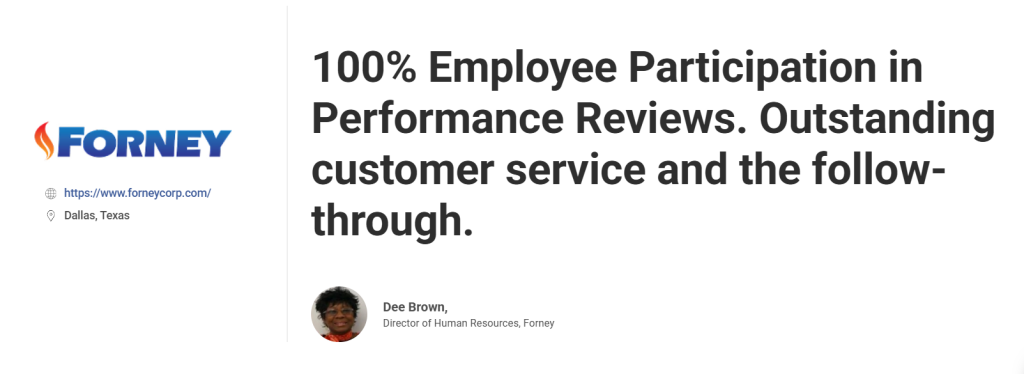
Case Study 2: Sandvine

Now that we’ve seen real-world scenarios, the focus shifts to the future. The workplace is transforming rapidly, and organizations need to prepare for the next wave of employee engagement trends.
The Future of Employee Engagement
The future of employee engagement will be shaped by data-driven insights, flexible work models, and new technology. These shifts will influence workplace culture, employee loyalty, team morale, and overall employee experience.
Below are the future trends in employee engagement that are expected to define the coming years.
People Analytics Becomes Central to Engagement
I’ve seen that data now drives the most effective employee engagement strategies. People analytics provides a clear view of team morale, retention risk, and employee experience.

The role of leadership in employee engagement is shifting from intuition to insight, where data tells leaders exactly how to act. This is one of the clearest examples of how technology is changing employee engagement.
Here’s how this trend will shape up:
- People analytics will predict disengagement early, allowing companies to act before problems escalate.
- Engagement survey data will be linked directly to recognition programs, performance reviews, and employee engagement activities.
- Dashboards will make feedback management transparent, helping leaders improve retention and workplace culture.
Hybrid Workplaces Redefine Culture
The rise of hybrid workplaces has permanently altered how organizations think about engagement.
I’ve watched companies struggle when engagement activities favored in-office staff while remote employees felt excluded. The future of employee engagement will depend on hybrid strategies that build inclusion, fairness, and equal access to recognition and growth.
This is what it means in practice:
- Virtual recognition and digital town halls will complement in-person activities, keeping engagement consistent.
- Hybrid employee onboarding programs will combine digital tools with face-to-face mentoring to protect employee experience.
- Employee engagement examples will include blended rituals that maintain team morale across locations.
Continuous Feedback Replaces Annual Reviews
Relying on annual reviews alone is one of the biggest mistakes I’ve seen in organizations. Continuous feedback gives employees timely coaching, recognition, and clarity.

In the future of employee engagement, feedback management systems will become as essential as payroll software. This will reshape performance reviews and make the employee experience more dynamic.
Here’s how it will play out:
- Annual reviews will be replaced with frequent check-ins and lightweight project retrospectives.
- Feedback management will integrate directly into collaboration tools, making responses part of daily workflows.
- Continuous feedback will directly strengthen employee loyalty and reduce turnover.
AI and Technology Transform Engagement
Technology is not just supporting engagement anymore; it is redefining it. I’ve seen how AI can analyze thousands of survey responses, identify patterns, and recommend specific employee engagement activities. This is how technology is changing employee engagement in real time, creating personalized employee experiences at scale.
The impact can be seen in these ways:
- AI will automate pulse surveys and interpret open-ended feedback more accurately than manual reviews.
- Platforms will integrate employee onboarding, recognition, and performance reviews into seamless systems.
- Case studies of employee engagement strategies will increasingly show measurable gains in retention and team morale driven by AI insights.
Employee Experience Becomes the True North
The most important shift I’ve noticed is the move from engagement as a score to engagement as a lived experience. The future of employee engagement will focus on the full employee journey, from onboarding to performance reviews to wellness programs.

Organizations that treat employee experience as the core will win the competition for talent.
Here’s how organizations will apply it:
- Employee experience platforms will unify recognition, onboarding, learning, and development.
- Engagement activities will prioritize wellness, inclusion, and belonging to strengthen workplace culture.
- Companies that prioritize employee experience will secure higher retention and employee loyalty.
Sounds good?
Now let’s wrap things up quickly.
Make Employee Engagement Your Competitive Edge
In a nutshell, think of employee engagement less like a corporate program and more like the secret sauce that holds a team together. When it’s done right, it doesn’t just boost surveys; it reshapes workplace culture in ways you can actually feel.
Recognition programs stop being “nice-to-haves” and start driving employee loyalty. Feedback management isn’t paperwork; it’s the fuel that keeps team morale running. And career development is no longer a perk — it’s the reason employees stay.
Hybrid workplaces now make continuous feedback essential, and people analytics has become the compass guiding every leadership decision. These are not passing employee engagement trends; they’re the future of employee experience.
And here’s the kicker: none of this works without the right employee engagement tools. From engagement survey software to recognition platforms and continuous feedback systems, the best employee engagement activities succeed because they’re supported by technology that makes action possible.
Frequently Asked Questions
2. What Is HR's Role in Employee Engagement?
HR’s role in employee engagement is to design strategies that enhance workplace culture and employee experience. This includes building recognition programs, managing performance reviews, supporting career development, and implementing feedback management systems. HR ensures employees feel valued, connected, and supported, which improves retention, employee loyalty, and overall engagement across the organization.
3. What Are the 4 P's of Employee Engagement?
The 4 P’s of employee engagement are Purpose, Progress, Pride, and Participation. Purpose connects employees to the mission, progress gives them a sense of growth, pride inspires loyalty through meaningful work, and participation ensures involvement in decision-making. These elements strengthen team morale and workplace culture, making them essential employee engagement strategies for organizations today.
4. How Many Types of Employee Engagement Are There?
There are typically three main types of employee engagement: cognitive, emotional, and physical. Cognitive engagement reflects how employees think about their roles, emotional engagement shows how connected they feel to the workplace culture, and physical engagement relates to the energy and effort they bring to tasks. Balancing all three creates stronger employee loyalty and retention.
5. What Are the Three Pillars of Employee Engagement?
The three pillars of employee engagement are communication, recognition, and growth. Communication ensures employees feel heard and informed, recognition validates their contributions and boosts morale, and growth provides opportunities for career development and skill building. When organizations focus on these pillars, they strengthen workplace culture, build employee loyalty, and improve overall retention.
Ready to 3x Your Teams' Performance?
Use the best performance management software to align goals, track progress, and boost employee engagement.


